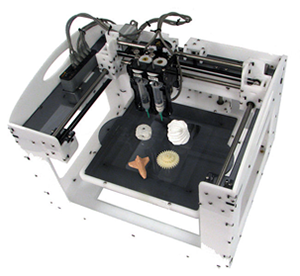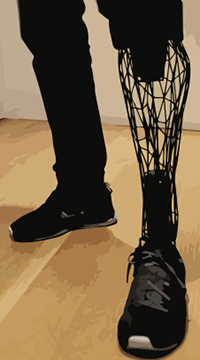InTrans / Dec 07, 2015
3D printing: How can it benefit you?
Go! Magazine
 posted on December 7, 2015
posted on December 7, 2015
This month’s series is dedicated to 3D printing. From its conception, 3D printing has been identified as one of the most important advances of our time. In this article, I will be discussing some of the positive impacts of 3D printers now and into the future.
In terms of technology, 1983 was a pretty exciting year. This was the year that CDs and camcorders were introduced to the general public. And although not as widely recognized at the time, 1983 was also the year that Charles “Chuck” Hull invented STL (stereolithography) and subsequently in 1986 founded 3D Systems.

Hull may not have come up with the original idea for 3D printing—that was Hideo Kodama of Nagoya Municipal Industrial Research Institute—but he did design the STL file format common to many 3D processes today.
3D printers, which can create anything from phone cases to gourmet cakes to animal organs to bridge models, has since gained popularity around the world and in multiple disciplines.
How they work
Chuck Hull’s first 3D printer creation was actually a small, plastic cup. Using a process known as sterolithography, in which layers of plastic are added and fused by ultraviolet lasers, a three-dimensional object can be created using a cross-sectional pattern. Did you know that this process was so difficult it took five months to produce Hull’s five centimeter cup?
However, today, using ideas from Hull’s original technology, complex products can now be created in a short period of time. For instance, a product known as “Form 1+” uses stereolithography technology to build a model from the bottom up using a laser to “dry” each layer. The Form 1+ also comes with a software that is easy to use and that can import models to be printed. The products printed can also be created through computer-aided design (CAD) software to create 3D objects. This technology is both versatile and precise.
Everyone is an inventor
With 3D printers becoming more affordable—ranging anywhere from $350-$5,000—the general public can now create customized 3D products right at home. The ability to invent personalized products as quickly and cheaply as being able to purchase mass-produced products may result in more independent start-up companies, or, at least, more personalized products on the market.
This means that more people can become inventors!
Since 3D goods can be produced on demand (and therefore cut out warehouses), products are able to be sold for affordable prices rather than sold in great quantities to be profitable. Although the initial costs (i.e., the printer itself and supplies) can be costly, these expenses in the long term are relatively affordable, especially if one is thinking about making this their at-home, full-time job.
3D printing is also especially helpful for bridge engineers who need to construct complicated bridge prototypes before tackling a large project.
For example, when YLE Engineers, a Polish design company, was tasked with building a functional bridge over Martwa Wisla River in Poland, they looked to 3D printing. Their complex ZMorph 3D printer was utilized to create a complex prototype model of the prospective bridge while simulating real environmental conditions to eliminate any flaws in the actual design. This saved them time and allowed them to avoid running into major issues during large-scale construction.
From complex printers, like the one mentioned above, to home 3D printers, this technology could change everything.
Reduced emissions
Imagine having a “family” 3D printer like you would have a family T.V. or computer. As I mentioned before, with more and more home-based or “family” 3D printers being purchased, this could change where products are made. This is an issue for those working in the field of supply chain management, where their jobs depend on the steady flow of goods from material sources and manufacturing through processing to the final customer.
Although it is debatable about how many imports we get from oversea producers in China, India, etc., the fact is that some of our products we use every day are shipped to the United States over a long distance. That means that they travel by truck, train, ship, airplane, and other vehicles (i.e., the transportation sector). In 2013, greenhouse gas emissions from transportation accounted for about 27 percent of total U.S. greenhouse gas emission, making it the second largest contributor of U.S. greenhouse gas emissions after the electricity sector.1
But what if we have the technology to produce some of these everyday products at home? Well, because of 3D printing, this would probably cost us less (if we already had a 3D printer and supplies) and be more eco-friendly overall.
Medical field transformed
3D printers are having a huge impact on the medical industry. For one, expensive products like prosthetics are already being printed more cheaply and making a huge impact on people’s lives. Models of human organs have also been printed and utilized before surgery so that surgeons can visualize exactly what they need to do on the patient before surgery begins. This reduces operation time and is safer for patients.

Additionally, printers are being utilized to reconstruct human and animal tissue. In 2013, a Russian company called 3D Bio created thyroid glands for mice. They later implanted those glands in the mice and found that it was functional.
In the future, scientists predict the ability to “print” new, functional organs like a lung, heart, or kidney. This would be done by taking living, human cells and allowing them to multiply; the resulting concoction is put into a 3D printer with specific directions for arranging them into an organ using the different cell types. Although these organs have never been printed and implanted in humans quite yet, many speculate we are not far from this reality. Just imagine: instead of waiting on a transplant list for months, hospitals could be equipped with 3D printers that would use your cells to replicate a new organ exactly when you need them.
Citations
http://www3.epa.gov/climatechange/ghgemissions/sources/transportation.html
Related links
Manufacturing
Pros and cons
http://www.philforhumanity.com/3D_Printing.html
How it works
http://www.mnn.com/green-tech/gadgets-electronics/stories/how-does-a-3-d-printer-work
By Jackie Nester, Go! Staff Writer